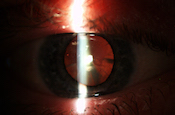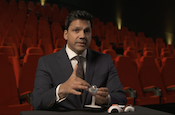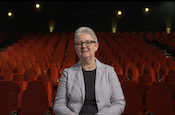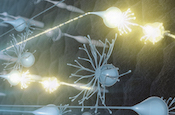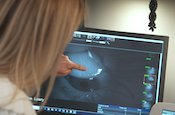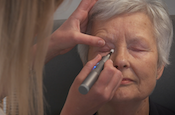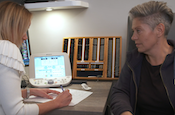Keyword search: 183 records shown
| Course categorySort by Course category Ascending | Course nameSort by Course name Ascending | Course summarySort by Course summary Ascending | New CourseSort by New Course Descending Descending |
|---|---|---|---|
| Video library | The Ageing Eye: Refractive correction for older patients |
This programme looks at the various refractive correction options available for presbyopes. Through a mix of filmed patient scenarios and expert advice four areas are considered: spectacle frames and lenses, contact lenses, correction with intra-ocular lenses, and managing presbyopic patients following refractive laser surgery. Topics: Ageing eye, Contact lenses, Spectacles, Dispensing, Refractive surgery, Intraocular lenses, Multifocal, Lenses, Tints, Presbyope, Frames, IOLs, Driving, Cataract. | No |
| Video library | The Ageing Eye: Charles Bonnet Syndrome |
A comprehensive overview of Charles Bonnet syndrome, based on the latest research. Includes advice on identifying the condition, addressing the topic with patients, appropriate management steps and what can be done to help sufferers. Topics: AMD, Ageing eye, Low vision, Dementia, Hallucinations, Psychology, Vision loss, Dominic ffytche, Visual impairment. | No |
| Video library | Developing Clinical Skills | No CPD Points
This programme looks at the application of three advanced clinical investigative techniques and shows how to undertake and interpret van Herick technique, the use of slit lamp and indirect lenses for assessment of the fundus and gonioscopy. Topics: Tonometry, Slit lamp, Gonioscopy, Volk, BIO, van Herick, IOP, Anaesthetic, Dilation, Goldmann, Glaucoma. Area of interest: MECS | No |
| Video library | The Ageing Eye: Adapting the Routine - Community practice | 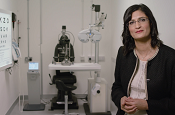 No CPD Points
In this programme, experts look at how to adapt the routine eye check when examining elderly patients including communication, ocular examination and refraction. It provides guidance on techniques to use and how best to modify an examination to ensure that elderly patients get the highest level of care and their individual needs are addressed. Topics: Communication, Ocular examination, Refraction, Binocular vision, Charts, Pupils, Visual fields, Legal, Visual assessment, Retinoscopy, Ophthalmoscopy, LogMAR, Contrast sensitivity, Lighting. | No |
| Case studies for peer review | Soft Toric Lens Fitting |
This case includes two videos and discusses corneal astigmatism, slit lamp examination results and fitting of soft toric contact lenses. Topics: Astigmatism, Soft toric lenses, RGP, RCL, Slit lamp, Toric, Aftercare, Bitoric, Gas permeable, Keratometry, Contact lenses. | No |
| Case studies for peer review | Rigid Corneal Lens (RCL) Fitting for Astigmatic Patients |
This case includes three videos and discusses corneal astigmatism, the fitting of spherical and toric RC lenses, aftercare and staining. Topics: Astigmatism, Soft toric lenses, RGP, Slit lamp, Toric, Aftercare, Bitoric, Gas permeable, Keratometry, Contact lenses, RCL. | No |
| Video library | Contact Lenses: Core Skills - Fitting and aftercare |
| No |
| Case studies for peer review | The Ageing Eye: Visual Impairment - Elizabeth |
In this session, delegates are asked to watch a short video that outlines a case scenario of a 67-year-old patient with cataracts and macula changes. Topics: AMD, Cataracts, Communication, Depression, Electronic aids, Low vision aids, Management plans, Mental health. | No |
| Case studies for peer review | The Ageing Eye: Visual Impairment - Moira |
In this session, delegates are asked to watch a short video that outlines a case scenario of an 81-year-old patient with macula degeneration. Topics: AMD, Charles Bonnet, Communication, Depression, Electronic aids, Lighting, Low vision aids, Management plans, Mental health. | No |
| Case studies for peer review | The Ageing Eye: Visual Impairment - Leonard |
In this session, delegates are asked to watch a short video that outlines a case scenario of a 93-year-old patient with glaucoma and severe sight impairment. Topics: Electronic aids, Falls, Field loss, Glaucoma, Low vision aids, Management plans, Mobility. | No |
| Case studies for peer review | The Ageing Eye: Visual Impairment - Ray |
In this session, delegates are asked to watch a short video that outlines a case scenario of a 60-year-old patient who suffered a stroke two months ago. Topics: Communication, Depression, Electronic aids, Field loss, Low vision aids, Management plans, Mental health, Mobility, Stroke. | No |
| Audio – Ocular disease and management | Sound Optometry: Episode 2 - Papilloedema |
In this episdoe, we hear about a clinical scenario where papilloedema was detected in a young girl. Michelle Hanratty then discusses the topic of papilloedema, its presentation, causes and potential treatment with consultant neuro-ophthalmologist Naz Raoof. Topics: Communication, Neuro-ophthalmology, Optic disc anomalies, Papilloedema, OCT. Area of interest: MECS. | No |
| Audio – Ocular disease and management | Sound Optometry: Episode 1 - Ocular Allergies |
   
In this episode, we explore how patients with ocular allergy seek clinical advice and treatment. We hear from a community pharmacist, often the first port of call for allergy sufferers, before discussing ocular allergy in more detail with Dr Peter Frampton. Topics: Allergic conjunctivitis, Seasonal and perennial allergy, Topical medications and contact lenses, Effective history taking, Remote consultations, Allergy vs adverse reaction. Area of interest: Independent prescribing. | No |
| Audio – Ocular disease and management | Sound Optometry: Episode 3 - Flashes and Floaters |

In this episode, Michelle is joined by Consultant Vitreo-Retinal Surgeon Stephen Lash and Clinical and Regulatory Advisor for the Association of Optometrists (AOP) Roshni Kanabar to discuss how to manage suspected retinal detachment. Topics: Retinal tear, Retinal detachment, Flashes and floaters, Posterior vitreous detachment, Record keeping, Communication, Referrals. | No |
| Audio – Clinical assessment | Sound Optometry: Episode 4 - Binocular Vision |
In this episode, we hear about a scenario in which a sixth nerve palsy was detected in an urgent remote consultation with an elderly patient. We also explore methods that optometrists have at their disposal to detect and manage binocular vision problems in children. Topics: Binocular vision assessment, Examining children, Amblyopia, Strabismus, Squint, Incommitant, Convergence insufficiency, Exercises, Ocular Motility, Stereopsis, Prisms, Double vision, Orthoptics, Referrals. | No |
| Audio – Ocular disease and management | Sound Optometry: Episode 5 - Acute Red Eye |
In this episode, optometrist Robert Longhurst discusses the increased incidence of viral conjunctivitis-related red eye during the COVID-19 lockdown of Spring 2020. Consultant Ophthalmologist David Lockington explores the investigation and management of acute red eye. Topics: Red eye, Viral conjunctivitis, Microbial keratitis, Contact lens complications, Independent prescribing, Emergency referrals. | No |
| Audio – Ocular disease and management | Sound Optometry: Episode 6 - Medical Retina |
In this episode, Michelle Hanratty explores the referral, investigation and management of wet age-related macular degeneration (AMD) with consultant ophthalmologist Rupal Morjaria. Topics: Medical retina, Age-related macular degeneration, Referrals, Retinitis pigmentosa, Patient communication, Gene therapy. | No |
| Audio – Professional matters | Sound Optometry: Episode 7 - Speaking Up |
In this episode, Michelle discusses the concept of Speaking up with David Hewlett, Group Director at FODO. We also hear from Julie Breen, Freedom to Speak Guardian for Tees LOC, who outlines her role within primary care optometry. Topics: Freedom to speak up, Speaking up, Raising concerns, Whistleblowing, GOC Standards of Practice. | No |
| Audio – Ocular disease and management | Sound Optometry: Episode 8 - Cataract, A tale of two surgeons |
In this episode, Michelle speaks with consultant ophthalmologist Arijit Mitra about his personal experience with cataract. We also hear from Ajai Tyagi, who shares his insights from a surgical perspective. The episode wraps up with valuable advice from both surgeons on referral practices and postoperative care for cataract patients. Topics: Cataract, Referrals, Patient communication, Monovision. | No |
| Audio – Ocular disease and management | Sound Optometry: Episode 9 - Suspicious Discs: When is a disc a disc at risk? |
In this episode, we explore a clinical case in which idiopathic intracranial hypertension resulted in severe visual symptoms and bilateral optic disc swelling. Michelle then discusses the key features of papilloedema, including its presentation, underlying causes and differential diagnoses, with neuro-ophthalmologist Dr Denize Atan. The second part of the episode focuses on the unilateral causes of optic disc swelling, offering a deeper understanding of how they differ from bilateral presentations. Topics: Optic disc drusen, Optic disc swelling, Optic neuritis, Optic neuropathy, Papilloedema, Referrals. | No |
| Expired | Safeguarding Children for Optometrists Level 2 (Certificates achieved - 05/01/22 to 20/01/25) | This accredited Level 2 e-learning Safeguarding course expired on 20 January 2025. If you have completed this course, you can print your certificate here.This course has been replaced with our Safeguarding Children for Optometrists Level 2 course, reissued in January 2025. | No |
| Expired | Safeguarding Adults for Optometrists Level 2 (Certificates achieved - 05/01/22 to 20/01/25) | This accredited Level 2 e-learning Safeguarding course expired on 20 January 2025. If you have completed this course, you can print your certificate here.This course has been replaced with our Safeguarding Adults for Optometrists Level 2 course, reissued in January 2025. | No |
| CPD courses | AMD: Part 1 - What is AMD? (Non-interactive) |
CPD Ref: C-100639 CPD Points: CPD Type: Non-interactive Closing Date: 31 December 2025 Domains: Clinical practice, Communication
The first part in this five-part series on Age-related macular degeneration (AMD) examines the anatomy of the macula, key risk factors, prevalence data, and the presenting signs and symptoms. Topics: AMD Series, Retina, Macula, Risk factors, NICE NG82, OCT, Smoking, Drusen, Wet, Dry, Diet, Anatomy, Neovascular, Prevalence, Charles Bonnet, Active, Inactive, Classification. | No |
| CPD courses | AMD: Part 2 - Physiology, pathology and classification (Non-interactive) |
CPD Ref: C-100641 CPD Points: CPD Type: Non-interactive Closing Date: 31 December 2025 Domains: Clinical practice, Communication
In the second part of this series, we explore the physiology and clinical examination of the macula to help identify AMD and other macular conditions. Emphasis is placed on the interpretation of OCT imaging to facilitate accurate differential diagnosis. Topics: AMD Series, Retina, Macula, NICE NG82, OCT, Drusen, Wet, Dry, Anatomy, Neovascular, Active, Inactive, Classification, Diabetes, CSR, Vein occlusion, Macular oedema, Vitelliform, Geographic atrophy, Reticular. | No |
| CPD courses | AMD: Part 3 - Assessment, management and referral (Non-interactive) |
CPD Ref: C-100642 CPD Points: CPD Type: Non-interactive Closing Date: 31 December 2025 Domains: Clinical practice, Communication
The third part in this series on age-related macular degeneration (AMD) examines clinical assessment techniques, strategies for effective patient communication, approaches to management and referral and the provision of low vision support. Topics: AMD Series, Macula, NICE NG82, Referral, Communication, OCT, Amsler, Drusen, Wet, Dry, Neovascular, Active, Inactive, Geographic atrophy, Smoking, Diet, Charles Bonnet, Driving, Vitamins, AREDS, Supplements, Eccentric viewing, Low vision, Visual impairment. | No |
| CPD courses | AMD: Part 4 - Patient case studies (Non-interactive) |
CPD Ref: C-103023 CPD Points: CPD Type: Non-interactive Closing Date: 31 December 2025 Domains: Clinical practice, Professionalism
The fourth part in this series on AMD presents three patient cases illustrating different stages of the disease, providing optometrists an opportunity to refine diagnostic skills and evaluate appropriate management and treatment options for each scenario. Topics: AMD Series, Active, Amsler, Communication, Depression, Diet, Driving, Drusen, Dry, Inactive, Low vision, Macula, Neovascular, NICE NG82, OCT, Referral, Retina, Smoking, Visual impairment, Wet. | No |
| Audio – Clinical assessment | Sound Optometry: Episode 11 - Myopia Management: Active not passive | No CPD Points Domains: Clinical practice, Professionalism
In this episode, we hear from both parent and child as they share their experiences with myopia management using soft contact lenses. Michelle Hanratty then speaks with optometrist Kathryn Webber about best practices in myopia management. Together, they discuss how to identify suitable candidates and offer practical advice on how to communicate the potential benefits of myopia management to patients and their families. Topics: Myopia management, Risk factors for myopia, Communication, Fitting contact lenses in children, Pathological myopia. | No |
| Audio – Clinical assessment | Sound Optometry: Episode 12 - Anterior Ocular Lesions |
Domains: Clinical practice, Communication
In this episode, we hear from a patient diagnosed with conjunctival melanoma, before Michelle Hanratty speaks with Professor Heinrich Heimann about lesions of the ocular surface and anterior chamber. Their discussion explores how to recognise key signs, identify associated risk factors and approach the investigation, management and treatment of affected patients. Topics: Conjunctival lesions, Uveal lesions, Ocular tumours, Referrals. | No |
| CPD courses | AMD: Part 5 - Treating AMD (Non-interactive) |
CPD Ref: C-100644 CPD Points: CPD Type: Non-interactive Closing Date: 31 December 2025 Domains: Clinical practice, Communication
In the fifth and final part of our series on AMD, we explore the treatment options of patients with the condition, including the anti-VEGF procedure in a hospital eye clinic. Topics: AMD Series, Active, Dry, Macula, Neovascular, NICE NG82, OCT, Referral, Visual impairment, Wet, Anti-VEGF, Intravitreal, Injections, Fluorescein angiography, OCT-A, PDT, Telescopes, Translocation, DARPin, Stem cell. | No |
| CPD courses | Cataract: Part 1 - Introduction (Non-interactive) |
CPD Ref: C-101637 CPD Points: CPD Type: Non-interactive Closing Date: 31 December 2025 Domains: Clinical practice, Communication
The first part in this series on cataract explores the definition and classification of cataract, its pathophysiology, risk factors and incidence, as well as practical guidance on patient assessment and referral criteria. Topics: Cataract, Cataract series, Classification, Pathophysiology, Risk factors, History and symptoms, Visual assessment, Contrast sensitivity, Referral, Nuclear, PSC, Cortical, Congenital, NICE. | No |
| CPD courses | Cataract: Part 2 - Management and treatment (Non-interactive) |
CPD Ref: C-101638 CPD Points: CPD Type: Non-interactive Closing Date: 31 December 2025 Domains: Clinical practice, Communication
The second part in this series on cataract explores the principles of cataract management and treatment, along with key surgical techniques. Topics: Cataract, Cataract series, Management, Intra-ocular lenses, Phacoemulsification, Surgery, IOL, Multifocal, Bifocal, Trifocal, Referral, Monovision, Accommodating, Cataract extraction, EDOF. | No |
| CPD courses | Cataract: Part 3 - Post-treatment (Non-interactive) |
CPD Ref: C-101640 CPD Points: CPD Type: Non-interactive Closing Date: 31 December 2025 Domains: Clinical practice, Communication, Specialty CPD (IP)
The third and final part of the cataract series addresses postoperative assessment, potential complications and their management and postoperative care pathways. Topics: Cataract, Cataract series, Surgery, Postoperative assessment, Complications, Pathways, CMO, Uveitis, Retinal detachment, IOP, PCO, Referral, Emergency, IOL, Dislocation. | No |
| CPD courses | Glaucoma: Part 1 - Definitions and classification (Non-interactive) |
CPD Ref: C-101644 CPD Points: CPD Type: Non-interactive Closing Date: 31 December 2025 Domains: Clinical practice, Communication
The first part of the glaucoma series provides an updated overview of glaucoma definitions and prevalence, and explores the classification of its various types. It also covers the signs, symptoms and risk factors to support more accurate differential diagnosis and timely referral. Topics: Glaucoma, NICE, SIGN, POAG, COAG, CAG, Congenital, Ocular hypertension, Prevalence, Secondary. | No |
| CPD courses | Glaucoma: Part 2 - Pathophysiology and risk factors (Non-interactive) |
CPD Ref: C-101645 CPD Points: CPD Type: Non-interactive Closing Date: 31 December 2025 Domains: Clinical practice, Communication
The second part of the glaucoma series reviews normal eye anatomy and the pathophysiological changes involved in the development of glaucoma. It also explores current theories on the causes of glaucoma and examines the risk factors associated with its different types. Topics: Glaucoma, NICE, SIGN, POAG, COAG, CAG, Congenital, Ocular hypertension, Prevalence, Risk, Corneal thickness, IOP. | No |
| CPD courses | Dry Eye Disease: Part 1 - Pathophysiology and epidemiology (Non-interactive) |
CPD Ref: C-101847 CPD Points: CPD Type: Non-interactive Closing Date: 31 December 2025 Domains: Clinical practice, Communication
The first part of Dry Eye Disease: The Complete Picture looks at the findings from the TFOS DEWS II report and the pathophysiology, epidemiology and risk factors for DED. Topics: DED, Ocular surface disease, TFOS DEWS II, Dry eye, Tears, Homeostasis, Osmolarity, Cornea, Evaporative, Aqueous deficient, MGD. | No |
| CPD courses | Dry Eye Disease: Part 2 - Diagnosing DED (Non-interactive) |
CPD Ref: C-101848 CPD Points: CPD Type: Non-interactive Closing Date: 31 December 2025 Domains: Clinical practice, Communication
The second part of Dry Eye Disease: The Complete Picture covers assessment and diagnosis as recommended in the TFOS DEWS ll report, including triaging questions and diagnostic tests and techniques. Topics: DED, Ocular surface disease, TFOS DEWS II, Dry eye, Tears, Homeostasis, Osmolarity, Cornea, BUT, Fluorescein staining, Meibomian glands, MGD, Blepharitis, Demodex, Questionnaires, Lids, Aqueous deficient, Evaporative. | No |
| CPD courses | Dry Eye Disease: Part 3 - Managing DED I (Non-interactive) |
CPD Ref: C-101905 CPD Points: CPD Type: Non-interactive Closing Date: 31 December 2025 Domains: Clinical practice, Communication
The third part of Dry Eye Disease: The Complete Picture covers the treatment of DED as recommended in the TFOS DEWS ll report. It includes lubricants, lid treatments, environmental and dietary modifications and in-practice treatments. Topics: Ocular surface disease, TFOS DEWS II, Dry eye, Tears, Homeostasis, Osmolarity, Meibomian glands, MGD, Blepharitis, Demodex, Lids, Aqueous deficient, Evaporative, Tea tree oil, Diet, Warm compress, IPL. | No |
| CPD courses | Dry Eye Disease: Part 4 - Managing DED II (Non-interactive) |
CPD Ref: C-101940 CPD Points: CPD Type: Non-interactive Closing Date: 31 December 2025 Domains: Clinical practice, Specialty CPD (IP)
The fourth and final part of Dry Eye Disease: The Complete Picture features the second unit on treatment of DED as recommended in the DEWSll report. It covers surgical interventions, patient adherence and the use of prescription drugs to manage DED, including those available to IP optometrists. Topics: Ocular surface disease, TFOS DEWS II, Dry eye, Tears, Homeostasis, Osmolarity, Meibomian glands, MGD, Blepharitis, Lids, Drugs, Antibiotics, Punctal plugs, Adherence, COM-B. | No |
| CPD courses | Glaucoma: Part 3 - Assessment (Anterior segment and anterior chamber angle) (Non-interactive) |
CPD Ref: C-101646 CPD Points: CPD Type: Non-interactive Closing Date: 31 December 2025 Domains: Clinical practice, Professionalism
The third part of the glaucoma series focuses on evaluating the anterior segment and angle to recognise key signs of glaucoma and identify major risk factors. Topics: Glaucoma, NICE, SIGN, POAG, COAG, CAG, Van Herick, Smith’s method, Gonioscopy, OCT, Referral, PDS, PXF. | No |
| Video library | Ocular Surface and Anterior Chamber Lesions in Daily Practice (May 2021 Webinar) | 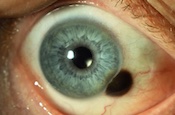 No CPD Points Domains: Clinical practice, Communication
This recorded lecture by consultant ophthalmic surgeon, Professor Heinrich Heimann provides an overview of the most important malignancies and pre-malignancies of the ocular surface and anterior chamber and how to spot them. Topics: Melanoma, Lymphoma, Naevus, Tumour, Conjunctiva, Ciliary body, Iris, Anterior chamber, Pigment, Cyst, Metastisis, Papilloma, Squamous cell. | No |
 No CPD Points
No CPD Points No CPD Points
No CPD Points


 No CPD Points
No CPD Points








